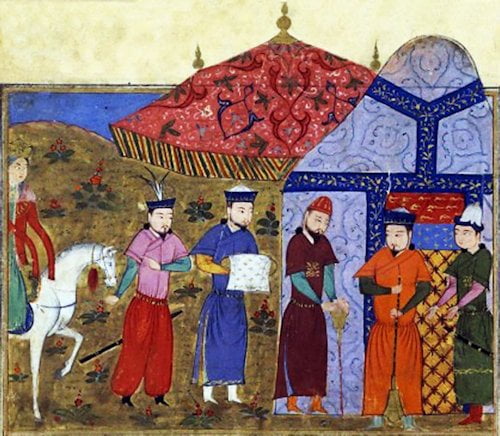The Mongol Empire in China lasted from 1271 CE to 1368 CE. Also known as the Yuan Dynasty, it was a period of Mongol rule over the Chinese empire. Kublai Khan, the grandson of Genghis Khan, was the person who managed to conquer China.
During the period of Mongol Rule in China, they introduced administrative and economic reforms. They were not interested in Chinese culture or traditions. Instead, Mongols maintained their own distinct identity.
At the same time, they allowed Chinese scholars to hold government positions. They even encouraged the practice of Confucianism.
How history views Mongol influence in China?
Up until the 21st century, most scholars of Mongol-era China emphasized the destructive influence of the Mongol empire. To be fair, a lot of that was due to natural disasters. People in the empire suffered from droughts and unusually cold water.
![]()
Scholars criticize the fact that Mongols were insensitive to Chinese cultural values. For example, one historian of the Mongol campaigns wrote, “With one stroke a world which billowed with fertility was laid desolate, and the regions thereof became a desert, and the greater part of the living, dead, and their skin and bones crumbling dust, and the mighty were humbled and immersed in the calamities of perdition”.
It is a fact that the Mongols did damage to the territory of China. There was a great loss of life. The population declined. They also eliminated one of the basic Chinese institutions, the civil service examinations.
Generally speaking, Mongols viewed China as just one section of their vast empire. In China, they classified the population into a hierarchy of four groups, with the Native Chinese at the bottom. They had the Mongols at the top, the non-Han Islamic population brought to China to help them rule, the Northern Chinese, and the Southern Chinese at the bottom.
How they changed life in China?
While many scholars and historians see only the destruction, Mongols did some good in China as well. Let’s see.
Extending the Grand Canal to Beijing
During the Mongol dynasty, the Capital of China was moved to Beijing. This eliminated the need for the Grand Canal arm flowing west to Kaifeng or Luoyang. The purpose of the canal was to transport surplus grain from the agriculturally rich valleys to feed the capital cities and large armies in northern China.
![]()
Kublai Khan ordered more than 3 million people to extend the Grand Canal, which is the longest canal in the world so that it reaches his capital. They extended it through hill country that earlier dynasties didn’t dig enough.
The canal gave Beijing direct inland access to southern cities and the Yangtze River basin for the first time. This allowed the northern territory to prosper.
Fun fact: The Erie Canal in North America draws inspiration from this particular Chinese architecture.
Using paper money
It was in 1273 that Kublai Khan issued paper banknotes backed by the government. At the time, these money were called chao. It remains one of the biggest innovations in the banking and monetary systems across the world.
While the Song Dynasty used paper currency as well, it was the Yuan Empire to use paper currency as the predominant circulating medium. When Marco Polo described the money to Europeans, they were astonished.
Paper currency helped increase trade with the rest of the world and facilitated prosperity in the empire.
Patrons of painters
The art of painting flourished during the Mongol Empire. Zhao MEngfu, one of the greatest painters, received a court position from Kublai Khan. Mongols supported and encouraged painters. You can say Mongols vastly influenced Chinese culture.
Life for artisans
Speaking of culture, the status of artisans in China was improved during the reign of the Mongols. Chinese people prized the products produced by artisans before, but not the artisans. Before Mongol rule, artisans didn’t have high status.
But that changed. The Empire valued artisanship and implemented many policies favoring the people that crafted these products.
![]()
For example, they gave them freedom from unpaid labor, tax remissions, and higher social status. During the Mongol era, artisanship reached new heights. Some of the products like spectacular textiles sand porcelains began appearing. The blue and white porcelain tea pots, a style that many associate with the Ming dynasty, was first developed during the Mongol Era.
Life for Merchants
Another group of people that benefited from Mongol rule is the merchants. They also had a relatively low status.
During the empire, Mongols initiated the Ortogh, a merchant association that helped people in the distance and business of long-distance trade. Mongols reduced some of the tariffs imposed on merchants and increased availability of paper money.
The end result was extraordinary increase of trade across the empire and throughout Euroasia.



